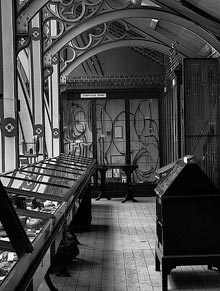About the 'Relational Museum' project and the methodology of research
This project charts the history and nature of the relations composing the Pitt Rivers Museum through analysing the history of its collections. Ethnographic museums used to be seen as 'us' studying 'them'. A more productive approach is to view museums as trans-cultural artifacts composed of relations between the museum and various kinds of communities. The Museum is convinced that collections represent an unusually rich source for writing the histories of institutions, disciplines, individuals and communities. We see the project as having model value for research in other ethnographic, archaeological and social history collections.
The Museum was successful in obtaining a grant of £328,026 from the ESRC: for which funding the Museum is very grateful. The project began in October 2002 and finished at the end of March 2006. The project was led by Chris Gosden and Mike O'Hanlon, both at the Pitt Rivers Museum. It has employed a number of people (including Sandra Dudley, Megan Price and Chris Wingfield, Laura Phillips, Naomi Bergmans and Helena Winston), but the two main researchers have been Alison Petch and Frances Larson. More information on the project can be found at the main Pitt Rivers Website
The Research Team undertook its research in two different ways:
Statistical analysis
We have carried out detailed statistical analyses of the Museum's collections between the year of its foundation (1884) and 1945 (the beginning of the end of the formal colonial period), charting the networks of social and material relations which were created to bring objects to the museum and present them for display and publication. Although ending the bulk of our analyses in 1945, we will make some consideration of more recent trends in the museum's history through to the present.
For further information about the statistical findings

Looking east on the south side of the upper gallery around 1898
(Detail of 1998.267.280.1 -.2, copyright PRM)
Archival research
We have also analysed written accounts pertaining to objects, ranging from travel diaries and letters describing their collection to museum archives, in order to understand the modes of knowledge surrounding objects, and their changes through time. A variety of different archives have been consulted in Oxford and elsewhere in the UK, including the Museum's own manuscript and photographic collection, London School of Economics, School of Oriental and African Studies (University of London), University of Birmingham, Royal Geographical Society, Cambridge University Museum of Archaeology and Anthropology, Cambridge University Library, the Oxford University Archives etc.
It was agreed to undertake specific research on six important contributors to the Museum's collections: Augustus Henry Lane Fox Pitt Rivers, Edward Burnett Tylor, Henry Balfour, Beatrice Blackwood, Charles and Brenda Seligman and John Henry Hutton.
The combination of a statistical understanding of the Museum and the archival accounts form the core material evidence of the project. The project team also developed theoretical ideas of relevance to museums, their histories and roles.


